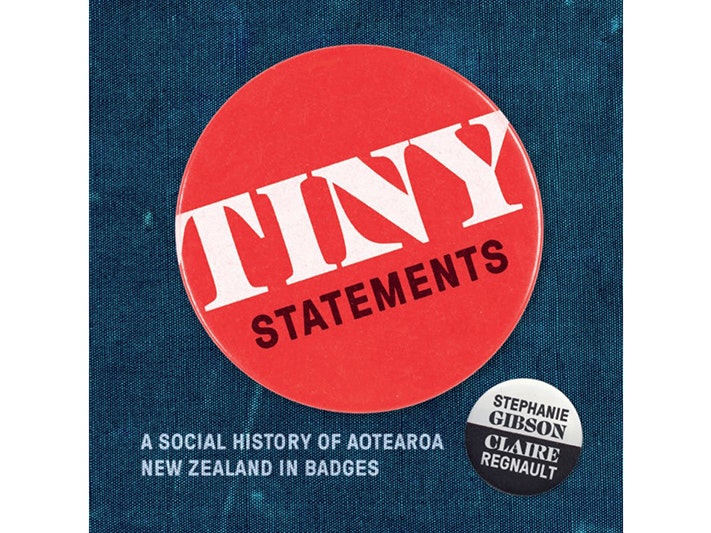Stephanie Gibson is Curator New Zealand Histories and Cultures at Te Papa. She researches the material and visual culture of protest, conflict and reform, as well as everyday life in Aotearoa New Zealand. Her continuing museological research focuses on museums and community participation. With Puawai Cairns and Matariki Williams, she was the author of Protest Tautohetohe, winner of the 2020 Ockham New Zealand Book Award for Illustrated Non-Fiction.
Claire Regnault is Senior Curator New Zealand Histories and Cultures at Te Papa and has worked in the art gallery and museum sector since 1994. Her curatorial practice is eclectic in nature and she is particularly passionate about New Zealand’s fashion history. She is an active member of the Costume and Textile Association of New Zealand and regularly contributes to the association’s symposia and journal. She is the author of Dressed, winner of the 2022 Ockham New Zealand Book Award for Illustrated Non-Fiction.
Stephanie Gibson and Claire Regnault. Photo by Yoan Jolly. Te Papa
"...they fill important gaps in the collection and enlarge the stories we tell, but also because the owners were totally into what we were trying to achieve." – Stephanie Gibson
Is it indeed possible to tell ‘A Social History of Aotearoa New Zealand’ through the badges we’ve worn?
Absolutely. When you focus intently on a particular type of object – such as badges – you quickly realise that they can encompass just about every facet of political, social, and cultural life. Our book features just a tiny selection of the thousands of badges in public and private collections throughout the country. We could have told many more stories.
The book features hundreds of badges. Tell us about some of your favourites.
SG: My favourites are some of the new acquisitions we made for the book, particularly the Polynesian Panther Party badges and Tāme Iti’s pins. Not only because they fill important gaps in the collection and enlarge the stories we tell, but also because the owners were totally into what we were trying to achieve.
CR: Dog mad, I am very fond of the jewel-like dachshund club badge which echoes their sleek elongated silhouettes, and the 24th Reinforcements’ bone-chomping bulldog! I also love the clever reduction of forms demonstrated in many of the badge designs, such the elegant profile of the para-archer, and the front view of the roller skate on the Levin roller skating club badge.
Most unusual badge?
SG: ‘Support S.A.M.’, because unless you knew what it meant, it could mean anything. Most badges have some sort of clue, but in this case, the designer’s intention was deliberately obscure to make people ask the wearer what it was about: The Society for the Abolition of Mrs and Miss (SAM).
Badge with the most moving back story?
The most moving badge in the book is the portrait badge of influential educator Teresia Teaiwa (1968–2017). It is both a deeply felt personal memorial and a public acknowledgement of her impact and legacy in Pacific Studies.
Most beautifully manufactured badge?
SG: I think the badges by Trevor Dick are beautifully manufactured and appear almost jewel-like; particularly the ones made from coloured-glass enamel fused onto gilding metal.
Most surprising badge story?
Probably the story behind the badge featuring a large silver guinea pig. The badge was made for members of the Wallaceville Laboratory Indoor Bowls Club. The Hutt-based laboratory carried out research into the health of farm animals, and used rats, mice, rabbits and guinea pigs (for whom someone was responsible for growing their greens) in their trials. Those who worked at the lab formed a tight-knit and highly social community. Employees and their families could join a myriad of clubs including the ‘Wallaceville Follies’, a choir, a slot car club, a film society and numerous sports teams. They even held their own mini-Olympics, competing in the Gumboot Throw and Water Bucket Spin.
What’s one new thing you learned while writing this book?
We learned that everyone has a badge story!
Which of these badges have reached furthest in the national consciousness, and why?
It depends on the context and timeframe. If we’re talking about work, then possibly the Post Office badge had the widest reach because New Zealand Post was such a big employer and so important to people’s lives.
In terms of activism in the 1970s and 80s, the heart symbol of Halt All Racist Tours or the Campaign for Nuclear Disarmament symbol were widely seen.
But ultimately, badges and pins bearing the silver fern and Anzac Poppy probably have had the most enduring reach.
What sorts of badges are you looking to add to Te Papa’s collection in the coming years?
We are always on the lookout for badges which represent major social and political movements and associations. We are also interested in badges relating to popular culture and fandom – we need more music badges – and contemporary uses of badges (e.g. pronoun badges).
What do you hope readers will take away from this book?
We hope readers and students will see that small and humble objects can tell big stories about Aotearoa and people’s lives.


